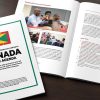John Warner Barber’s 1840 engraving of the rebellion. Though the violence of the imagery upset abolitionists, it is sympathetic to the rebels. The Africans are individualised as the artist had met and drawn them in New Haven prison. Cinque is on the left with a raised machete. The cabin boy Antonio is keeping out of the fight in the rigging on the far left, as he did in the real rebellion. The cook’s body can be seen in the background.
Amistad-910×512
You Are Here: Home » Reparations » ‘I’d rather die than be a white man’s slave’ – the story of the Amistad Rebellion » Amistad-910×512

Here are some quick links to NAARC’s website to help you get involved and stay informed:
• Donate
• What is NAARC?
• What is NAARC’s 10 Point Plan?
• Forums & Conferences
• NAARC News
• Reparations Advocate Sign Up
Recent Posts
-
 IBW’s Grenada Action Agenda December 12, 2024
IBW’s Grenada Action Agenda December 12, 2024 -
 Symbols and Insights of Kwanzaa: Deep Meanings and Expansive Message December 9, 2024
Symbols and Insights of Kwanzaa: Deep Meanings and Expansive Message December 9, 2024 -
![AEO, Ras Kass, Nkechi Taifa, Kymrence Young & Tricky Trev.) (feat. Young RJ [Slum Village], Ras Kass, Nkechi Taifa & Kymrence Young)](https://ibw21.org/wp-content/uploads/2024/12/organizing-anthem-AEO-Agitate-Educate-Organize-1600x900-1-100x100.jpg) FirstRepair and BLIS Collective Release Single “Agitate, Educate, Organize” (AEO) to Amplify Black Reparations Movement December 9, 2024
FirstRepair and BLIS Collective Release Single “Agitate, Educate, Organize” (AEO) to Amplify Black Reparations Movement December 9, 2024 -
 DEI is Dying: What is Our Response? December 4, 2024
DEI is Dying: What is Our Response? December 4, 2024 -
 Vantage Point: Ready for Reparations in NY State? Rising Crime, Perception or Reality? December 2, 2024
Vantage Point: Ready for Reparations in NY State? Rising Crime, Perception or Reality? December 2, 2024









